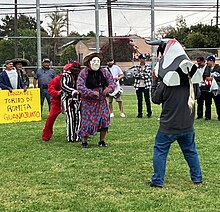Mexican mask-folk art
Evidence of mask making in the region extends for thousands of years and was a well-established part of ritual life in the pre-Hispanic territories that are now Mexico well before the Spanish conquest of the Aztec Empire occurred.[2][4] Funeral masks were reserved for the burials of the very elite such as that of King Pakal and were works of art, made of jade, shell, obsidian, hematite and other precious materials of the time.[5] Masks used in theatrical performances and dances varied widely: from depictions of the various animals of the Mesoamerican world, to images of old men and women generally for comedic relief, to designs that made fun of neighboring ethnic groups.[7] After the Conquest of the Aztec Empire, a number of Spanish historians noted indigenous religious rituals and ceremonies including those that used masks.[6] The Spanish banned pre-Hispanic religion but the evangelizers used the cultures’ propensity for masks and spectacle to propagate the new faith, through plays and dance.[11] Other masked dances developed in relation to Holy Week, Day of the Dead and the Conquest of Mexico, as well as Carnival, a European festival introduced by the Spanish.[12] The developing dances and other masked events became part of a syncretism of Catholic and native traditions and belief, especially Carnival and Holy Week, with the first coinciding with the Aztec New Year and new agricultural cycle.A number of these masks have been passed down from father to son, such as those of El Santo, Blue Demon, Los Hermanos Dinamita, Tinieblas and Dos Caras.In the case of a bout called “lucha de apuestos” the loser loses his mask and his real face is revealed.[29] Masked events range from small part parts on ranches, tribes and neighborhoods to large town and city comicons for the major events of the Catholic calendar such as Christmas, Carnival, Holy Week, Feast of the Cross, Corpus Christi, Day of the Dead and the feast days of major saints.[30] Notable Carnival celebrations include “tiger” pageants in Oaxaca, Chiapas and Tabasco; portrayals of colonial village life in State of Mexico; and a reenactment of the Battle of Puebla in Huejotzingo.Another popular type of mask at this time is one that ridicules the wealthy and powerful of colonial Mexico, such as with the dance of the Chinelos in Tlayacapan, Morelos.[24] Pageants and here are groups of “persecutors” of Jesus which can be called “judios” (Jews), “fareséos” (Pharisees), “romanos” (Romans) or “chapokobam.”.Another area with a high demand for masks is Chiapa de Corzo, for the Parachicos dance performed for the feast of Saint Sebastian by thousands of dancers.[42] Other materials used for masks include wax, fired clay, leather, cloth, wire mesh, sheet metal, rubber tires, cardboard and papier-mâché.Other areas that use wax in this way include Villa de Zaachila, San Bartolo Coyotepec and Zapotec communities near the city of Oaxaca .[9] The smallest masks measure between ten and fifteen centimeters wide with the rest of the face, including the mouth, covered by cloth.[49] The majority of Mexican masks depict human male faces, especially those for Carnival, Holy Week, Day of the Dead and local saint festivals.[1] Papier-mâché (cartonería) masks, made in Celaya, Guanajuato and Mexico City, are generally used by children for Carnival and Independence Day festivities.[46] Masks depicting European faces relate to Mexico's colonial history mostly and can represent the Spanish, the French, a king, a Christian fighting a Moor, a hacienda owner and more.[50] In many versions, Saint James Matamoros also appears in the drama, distinguished by a more elaborate headdress and a hobby horse fastened to the waist.[7] In Tlaxcala, for the Dance of the Catrines (Dandies) performers wear masks with pale skin tones and hold up umbrellas as a petition for rain.[30] Since women almost never participate in traditional dances, scenes that involve female characters are played by young men wearing masks.[29] La Malinche, interpreter for Cortés, is most often shown this way, but sometimes can be depicted as a sexy woman, with a mask that shows gaudy makeup.[18] Other non-conformist women include antisocial characters such as “Las Viudas” (The Widows) of Carnival in Nezquipayac and La Borracha (The Drunk Woman) from the Danza del Torito in Guanajuato.[29] Since pre-Hispanic contact almost all of the animals native to the country have been represented in masks, including monkeys, armadillos, coatis, rabbits, boars, vultures, fish, alligators, lizards and more.The behavior of this tiger character varies from fighting to being pursued by hunters, but the symbolism is most often related to the agricultural cycle and the rainy season on which it depends.[25][58] In a version of the dance in Michoacán, the depiction of the elderly is dignified, with the Danza de los Viejitos performed on major days of the Catholic calendar, especially between Christmas and Candlemas.[25][58] However, dancers with masks of an old man can also have a comic function, as a kind of side show to the main event, performing singly or in pairs.[50] Masks to indicate the indigenous in the Tastoanes dance often originally had scorpions painted on them, but evolved to include hooked noses and other grotesque features.

















Museum of Popular ArtMexicoSpanish conquest of the Aztec EmpireMexican Independencelucha librepapier-mâchéAfro-Mexicansthe devilDallas Museum of ArtMesoamericanTequixquiacState of MexicoJaguareagle warriorsKing PakalobsidianhematiteTeotihuacanArt Institute of Chicagopageant that reenacted the battles between Christians and MoorsHoly WeekDay of the DeadCarnivalHernán CortésLa MalincheAztec New YearIndependenceMexican InquisitionMexican RevolutionTlaxcalaPueblaOaxacaChiapasMichoacánBattle of PueblaPedro InfanteCantinflasHalloweenEl Chapulín ColoradoKarmatronEl SantoBlue DemonLos Hermanos DinamitaTinieblasDos CarasSonoraMuseo Nacional de la MáscaraNacajucaFeast of the CrossCorpus ChristiTabascoHuejotzingoChinelosTlayacapanMorelosPhariseesHuastecsChontalsApetatitlán de Antonio Carvajalcity of TlaxcalaChiapa de CorzoParachicosSaint SebastianNayaritSinaloaMaundy ThursdayGood FridayErythrina coralloidesPinus ayacahuitePapantlaZoquesPoplarmesquiteavocadoHidalgoZacatecasTonalá, JaliscoVilla de ZaachilaSan Bartolo CoyotepecZapoteccity of OaxacamachetesGuerreroTeloloapanPhilippinescartoneríaMetepecJaliscoQuerétaroCelayaGuanajuatoMexico CitySan Andrés TotoltepecMexico City Alebrije ParadeHoly LandVeracruzSaint James MatamorosDavid vs. GoliathhaciendaPurépechaMuseo de Arte PopulararmadilloscoatisColimaHuavesSan Mateo del MarocelotCarnival of Santa Marta Acatitla, IztapalapaValley of MexicoHuehueteotlNew Fire CeremonyDanza de los ViejitosCandlemasMixtecsCuilapan de GuerreroSierra de Juarez of OaxacaZitlalaTlalocTezcatlipocaBaby JesusMexican handcrafts and folk artMexican ceramicsCeramics of JaliscoPottery of MetepecSoteno familyBarro negro pottery